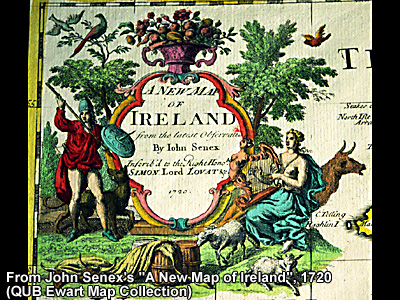
Following the Williamite victory came the longest sustained period of peace in the history of Ulster but, though Sir Nicholas Acheson and the other proscribed individuals returned to their livings, the Presbyterians and Catholics of the area once again suffered.
Catholics were refused the right to vote or bear arms and could not hold land for a period longer than thirty-one years. Upon the death of a Catholic landowner land could not be willed to a son but had to be shared equally among all sons thus diminishing the Catholic hold on the land. Denied the right to publicly practice their religion, Catholic families established 'hedge schools', small gatherings of students in old barns or cottages, to educate them as to the history and culture of Gaelic Ireland. This method allowed the Gaelic tradition to flourish throughout the era of the penal code. However, increasing Anglicisation of place names and the conducting of business in the English language eroded the intention of these schools. Some introduced reading and writing in the English language to allow students to advance themselves in an English world while still attempting to maintain a Gaelic influence on the lives of Catholic young people.
Under the penal code, presbyterians were forced to pay tithes to the Church of Ireland and Presbyterian marriage was not recognised as legal. They could hold office subject to a Sacramental Test but to partake of the Church of Ireland sacrament was to violate their religion. Faced with such measures Scots-Irish inhabitants, mostly of the Presbyterian denomination, left the country heading for a new life in America where they would prove to be extremely influential. Records of the day were ill-kept and many have not survived so we cannot be certain of the exact numbers who emigrated. However, the Presbyterian exodus coincided with an influx from Scotland of settlers fleeing famine in their native land. This balance of emigration and immigration ensured community life did not suffer.
The economic situation, too, showed signs of recovery as trading exports expanded. Estates, such as Gosford, demonstrated signs of greater efficiency as tenants diversified into the production of cotton and linen products in addition to the cultivation of the land for agricultural reasons. Though linen manufacture would remain a cottage industry for many years, it raised a number of tenants above the level of subsistence farming.
Presbyterians received some freedom in 1719 with the adoption of the Toleration Act. At the turn of the century, the Presbyterians in the community had formalised their church structure and appointed a full time minister. The relaxation of outside pressures was demonstrated by internal wrangling that led to a split within the church in 1739.
Gosford Estate flourished in the first half of the eighteenth century. Sir Arthur and Lady Anne Acheson entertained widely and cultivated a high society circle. One notable visitor was Gulliver's Travels author, Jonathan Swift. Swift resided at the Acheson manor house on three occasions between 1728 and 1730. During his lengthy residences, he composed a significant volume of poetry in his well known satirical style.
It was during this time that the Hamilton land at Hamiltonsbawn came into the possession of the Acheson family. Swift, in honour of the event, composed a witty appraisal of a dinner conversation "The Grand Question Debated: Whether Hamilton's Bawn should be turned into a Barrack or a Malt House". Unrest throughout the county offered the answer and the bawn was for a time turned into a barrack. The disturbances throughout the 1760s were the result of heavy cess being imposed upon the freeholders in the area, combined with a lack of parliamentary equality which caused agitation and led to the army being sent to re-establish control of the county.
